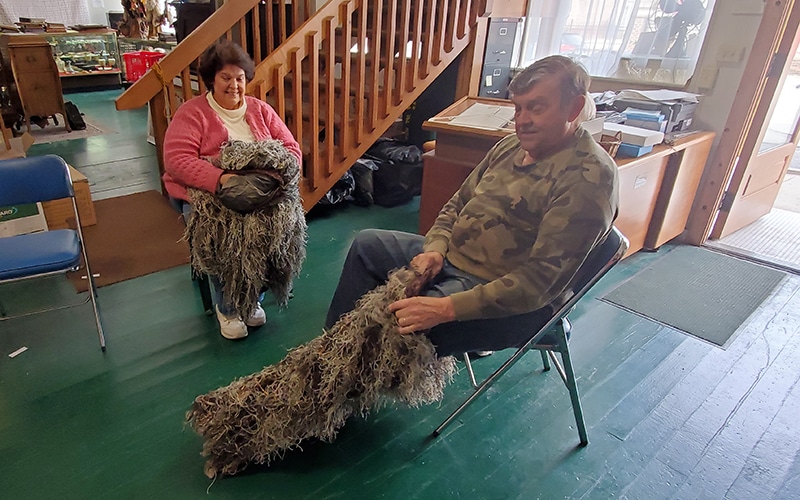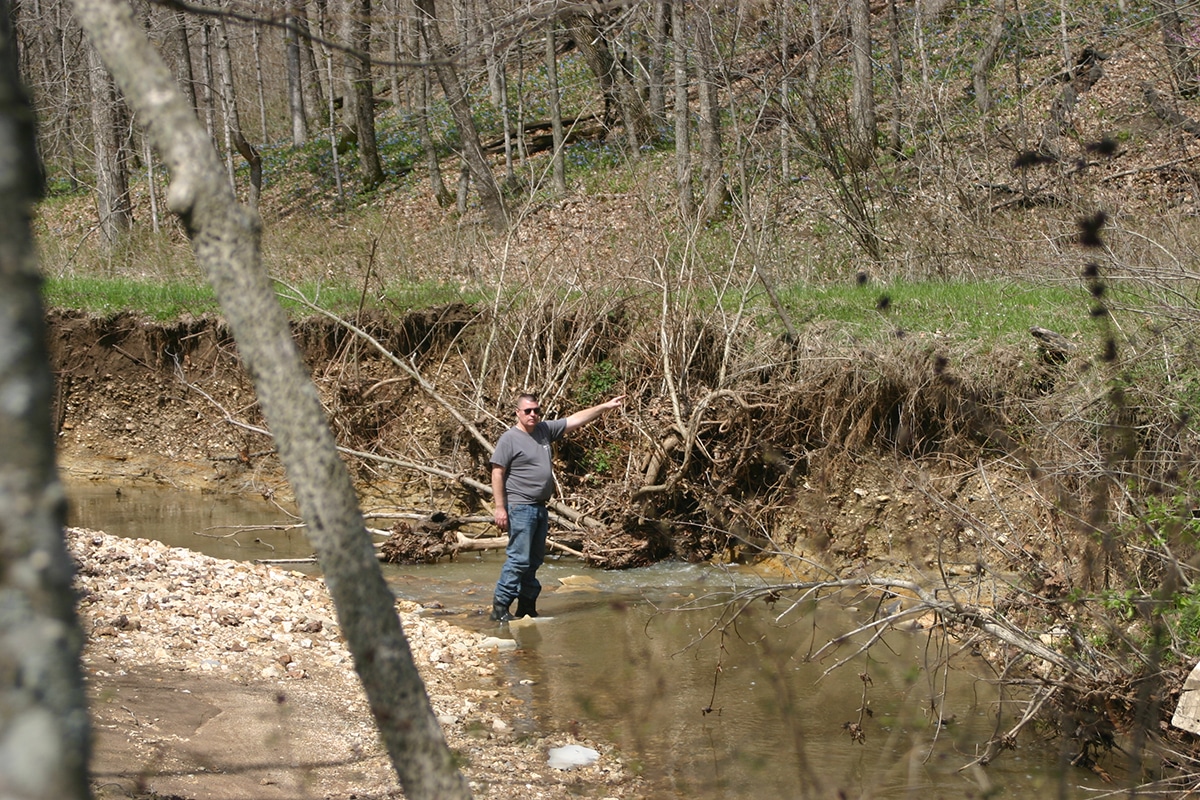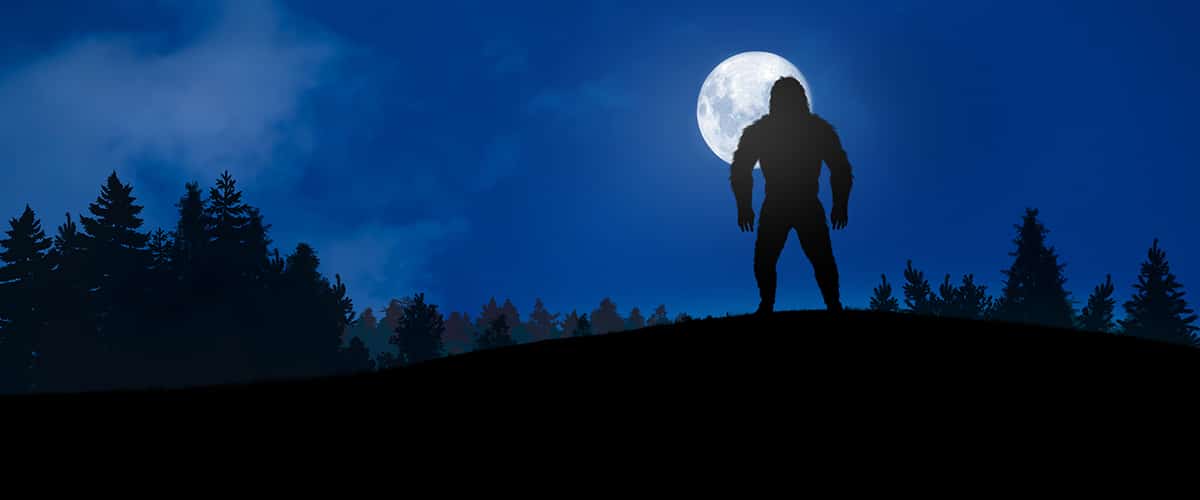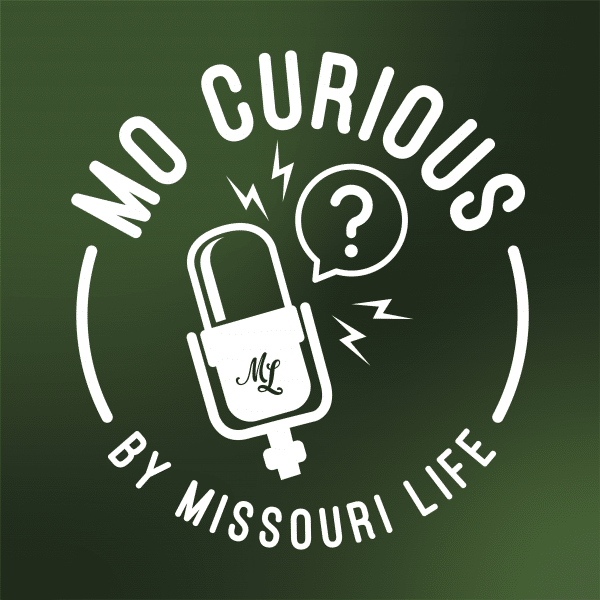
The larger-than-life story still lurks among us
This article originally appeared in the July/August issue of Missouri Life magazine.
Whistling a raspy screech as it lands, a red-tailed hawk gently glides to perch atop a gnarly oak tree. The regal tone punctuates the hurried chatter of squirrels and a blue jay’s cantankerous, persistent cry.
Nothing all that unusual about the collective calls, a familiar alert that an intruder is nearby. On this warm, breezy April morning in Louisiana, Missouri, are the woodland critters and birds announcing the arrival of a man at the edge of their briar-laden haven? Or is there something else in those woods, perhaps something that resembles the something that set this town on edge and hatched an international news sensation 50 years ago?
After all, the warning signals are coming from Marzolf Hill, a small stone’s throw from the end of Allen Street, where the legend of Mo Mo, the Missouri Monster, emerged in July 1972.
A Beast Appears
Hundreds of newspaper and broadcast accounts share common denominators of the Mo Mo story genesis behind the Harrison home at 1004 Allen Street near Marzolf Hill. It goes like this:
On July 11, 1972, 15-year-old Doris Harrison watched her brothers, ages 5 and 8, play outside as she cleaned a bathroom sink. Startled by her brothers screaming, Doris looked out the window and saw a massive, hairy creature at the edge of the woods. The beast, maybe seven feet tall, appeared to have blood on its unkempt fur and clutched a dead dog under one arm. Doris also said a putrid odor wafted through the air and into the open window.
In a panic, Doris rushed her brothers inside and called her father, Edgar Harrison, who worked for the Louisiana Board of Public Works. Edgar got home, called his wife, Betty, home from work, packed up the family (the Harrisons stayed with relatives for a few days), and rallied townsfolk to hunt for the creature.
The beast, maybe seven feet tall, appeared to have blood on its unkempt fur and clutched a dead dog under one arm.
That’s not the end of the story, of course, but it is the place where the story begins to grow, watered and fertilized by additional details and purported sightings. It wasn’t long before others reported hearing an animal growling and screaming. A farmer reported encountering the creature. Homeowners kept close watch on their pets to keep them from becoming sasquatch supper.
It was also the work of—in the words of Priscilla Giltner, a Louisiana High School teacher—“general tomfoolery.”
Hunting for Mo Mo
Newspapers around the country picked up the story. Gus Artus, a Missouri Department of Conservation wildlife official, told The Louisiana Press-Journal that he hoped the story would die down before “a bunch of adventure-seekers” overran the community. But more than that, Gus and the local police chief, Shelby Ward, feared for the public’s safety, not because of Mo Mo, but because of all the firearms.
At one point—or so the stories go—as many as 100 men armed with rifles, shotguns, and pistols ascended the wooded Marzolf Hill to hunt the creature.
These days, there’s rarely any mention of Mo Mo. The newest generation doesn’t recognize the name of Marzolf Hill; the site is now known as Star Hill.
“That part of the story took on a life of its own, too,” says one of the men gathered for morning coffee at Joe’s Jug, the Fastlane convenience store at 3508 Georgia Street. Except to confirm that he and his senior pals were sitting at “the liar’s table” (there’s one in almost every small town), he declined to identify himself. “A hundred armed men. Or just one or two. But there were people up there with guns at night.”
News reports detailed a three-hour search of 100 acres, led by Gus, involving law enforcement officers and volunteers. They found two disturbed dog graves and scattered bones, but no Mo Mo. Gus told reporters who were waiting for the story of a lifetime, “I am convinced, and the rest of us are also, that there is nothing that even looks like a monster on Marzolf Hill.”

Merchants Create Monster Sales
Doris’s sighting begat a media frenzy that eventually gave the creature a name: Mo Mo, although it appears that title didn’t come about until nearly two weeks later.
By the first weekend of August 1972, local merchants decided to cash in on their town’s new notoriety, joining together for a Mo Mo Sidewalk Sale. With denim jeans for $2.50 at JC Penney, $60 coats marked down to $20 at The Carol Ann Shop, and even a Mo Mo Burger at a local restaurant, shoppers packed the streets. The sidewalk sale event birthed the local Mo Mo Days festival for the next few years.
“It was a fun time,” says Herbert Sisco, one of the men sipping coffee at Joe’s Jug. “It’s an amazing story.”
Even more amazing? Herbert read about it while working for an American pipeline company in Rio de Janeiro, Brazil. (Incidentally, Edgar was Herbert’s wife’s uncle, and while Edgar had a penchant for telling “tall tales,” Herbert remains mum on whether Mo Mo was one of those tales.)
These days, there’s rarely any mention of Mo Mo. The newest generation doesn’t recognize the name of Marzolf Hill; the site is now known as Star Hill. Save for supposed bigfoot sightings mostly to the area south in or near Cuivre River State Park, and west toward Bowling Green—where William Magee has a farm where he and others have seen a bigfoot-like creature—Mo Mo is almost a forgotten mystery for locals under 50.
She Knows—But Won’t Say
For Priscilla Giltner, there never was any mystery. In fact, she says she knows the identity of Mo Mo and the reason there weren’t other sightings after the appearance outside the Harrison house.
“They were afraid Mo Mo was going to reappear,” she recalls. “He wasn’t going to reappear. He was probably on the ground hiding or at home scared to death.
Priscilla and her family were vacationing at a campground in Mississippi in July 1972 when her son returned from the campground office with a newspaper that proclaimed in big, bold letters, “Bigfoot has found a friend in Louisiana, Mo.” Priscilla taught college prep English, English literature, grammar, and public speaking—and, perhaps quite fittingly, drama—at Louisiana High School.
“In my estimation, they did not mean for it to get as big as it did. It got out from under them.” Retired Louisiana school teacher Priscilla Giltner
“I said, ‘Good lord, I’ll bet you he did this,’” she remembers saying, still declining to say who “he” was. She found a pay phone and called the boy’s house. He answered. “I said, ‘Did you do this?’ and he said, ‘No, but I know who did. I swear to you, Mrs. Giltner, I was not in on it,’” she recalls. “But he told me the three boys’ names.”
She still won’t say who they were. “And I never will,” she says. “It’s done.” Priscilla describes the Mo Mo pranksters as “nice boys.”
“They weren’t dope fiends or alcoholics. They just got together and decided to do something like this,” she says, adding that they apparently designed a Mo Mo costume—“maybe an old mink coat”—and went to Marzoff Hill where two of the hoaxers helped the taller, more husky lad put on the outfit. She’s not even sure if the other two accompanied the costumed Mo Mo teen down the hill to the Harrison’s yard.
“In my estimation, they did not mean for it to get as big as it did,” Priscilla, now 86, adds. “It got out from under them.” Her husband, Don, now 88, is the former mayor of Louisiana. He suspects that the boys submerged their homemade monster costume in the Mississippi River.
‘It Put Us on the Map’
Just months before her death in 2021, Doris Harrison told reporters and friends that she was tired of being questioned— and doubted—when it came to her Mo Mo sighting.
“I talked to Mrs. Harrison,” says Brent Engel, area historian and co-president of the Louisiana Area Historical Museum. “She was extremely adamant about it. I don’t think she was making it up. Doris Harrison went to her grave saying you couldn’t tell her it didn’t happen.”
Priscilla is sure that Doris saw something: perhaps a high school student dressed as a monster—but not a foul-smelling, other-wordly creature clutching a dead dog. Priscilla is also sticking to her story.
“I thought it was one of the funniest things I’ve ever known about,” she says. “I think it’s one of the most inventive things that’s ever happened here. It put us on the map.”
He Says He Saw It, Too
William Magee is a self-proclaimed cryptozoologist and bigfoot researcher. Nineteen years after Mo Mo roused the residents of Louisiana, William was camping on his family’s property in rural Bowling Green in spring 1991. As he followed the curvature of a creek on his four-wheeler, he drove around a bend and spotted a large creature squatting in the creek, a mere 30 feet away.
William describes the creature as about seven feet tall, somewhat “hunched,” and covered with black-brown hair. There was a brief moment of eye contact; the creature’s face was “more human than primate, not ape-like,” he recalls.
In an instant, he says, the creature—which the Magee family now refers to as “Mo”—leaped straight up and over the roughly eight-foot-high creek bank.
“It could have been a split-second. It could have been 20 minutes,” William says. “You’re looking at something you’re told doesn’t exist. But it’s looking at you.”
His first reaction was fear—not necessarily feeling threatened, but similar to the feeling of unknowing, like hearing something bump in a dark house. His son-in-law, Ben, confirmed also seeing it on Valentine’s Day 2015, getting a good look at their Mo as it ran and passed under a powerful dusk-to-dawn light across the road.
“I’ve seen this thing with my own eyes. Had I not seen it with my own eyes, I’d be a little skeptical.” Cryptozoologist and bigfoot researcher William Magee
William’s grandfather, an avid hunter, trapper, and outdoorsman, had reported multiple encounters with Mo during the years, and William’s father also had similar stories. Other visitors to the Magee property have seen the unidentified creature, which seems to disappear for a few years at a time, leading William to conclude—as other bigfoot enthusiasts have done—that the unidentified something is migratory.
One Facebook page devoted to bigfoot researchers and devotees features a bigfoot migration map, among other details that paint a picture of bigfoot diet, habitat, breeding, and more. As expected, those pages and groups have their share of skeptics even within the ranks.
On one page, an individual posted a brief story about his suspicion that there were “several members of a bigfoot family” near his property. One of the first comments to follow announced, “I just found a nest of leprechauns in my backyard.” And then, “Are they Stephen King leprechauns or Lucky Charms leprechauns?” That’s par for the course, William says.
“People don’t want to talk about it,” he says. “People will think you’re crazy or you’ll be laughed at.” William, 51, is an aviation boatswain’s mate and aircraft mechanic with the Navy Reserves.
“I’ve seen this thing with my own eyes,” William says. “Had I not seen it with my own eyes, I’d be a little skeptical.”

‘There’s No Scientific Evidence’
In nearby Lincoln County, most notably at or around Cuivre River State Park, published news reports have chronicled such sightings in the past year. At least three people have reported sighting a bigfoot-like creature at Bowling Green Lake in the last three years. Missouri radio broadcasts and newspaper reports have dotted the news feed with sightings and mysterious encounters throughout the state in the first six months of 2022.
But why are there no non-blurry photos of this creature, even on trail cams? William believes the creatures have learned to avoid trail cams—perhaps alerted by the infrared light that emits from the cameras?—and he points out that people who are in a panic or overly excited have trouble taking photos that are in focus.
“I’m not going to say it’s true. I’m not going to say it’s false. I’m going to leave it up to science to prove, or somebody to bring in a body.” Louisiana Area Historical Museum Co-President Brent Engel
Reliable, credible photos, DNA evidence, or the bones or remains of a bigfoot is evidence that state and federal wildlife officials throughout the country haven’t seen, says Joe Jerek, spokesman for the Missouri Department of Conversation. At first, Joe declined to comment, dismissing the bigfoot question, “Because it’s a cryptid.” (Cryptids are creatures of legend and lore, such as bigfoot and the Loch Ness Monster.)
“The Missouri Department of Conservation bases its work on science and scientific evidence,” Joe adds. “There’s absolutely no scientific evidence of bigfoot or the Missouri Mo Mo.” However, he contends, “It’s possible that people may mistake a large black bear for a cryptid.”
William says he’s not surprised by that observation. He insists, “I know what a bear looks like. It was not a bear.” As far as that puzzling lack of good photos in the cell phone age? “They’re not going to stop and pose for a selfie with you.”
Some Resented the Media Hype
Brent Engel, the co-president of the Louisiana Area Historical Museum, says the bright media spotlight from a half-century ago was “mixed blessing and curse. I think some of the resentment about those memories from 1972 is that some of the national media portrayed Louisiana as a bunch of hicks—banjo-playing, 12-toed misfits—out in the middle of nowhere.”
Today, Louisiana residents are eager to talk about the thriving businesses, vibrant civic groups, strong school system, attractive homes, and antebellum-era houses that evoke images of yesteryear when Louisiana played a role in the development of Missouri.
So where does Brent stand on the Mo Mo question? He’s talked to Doris Harrison, who swears it was real, and he’s talked to Priscilla Giltner, who swears it was a hoax.
“I’m not going to say it’s true.” Brent says. “I’m not going to say it’s false. I’m going to leave it up to science to prove, or somebody to bring in a body.”
Ready for more Mo Mo stories? Click here.
Mo Mo Days will be revived on Independence Day weekend, July 1–4. A 1972-themed Bill Whyte concert at the Elks Lodge gets Mo Mo Days started at 7 p.m. Friday, July 1. Bill is the Nashville recording artist who recorded “Mo Mo the Missouri Monster.” Tickets are set at the 1972 price of $5. Museum board members will be selling pulled pork sandwiches, chips and cookies for $5 and the Elks will be selling beverages.
Saturday will be sidewalk sales and a flea market, and the Louisiana Area Historical Museum will be open, with Brent Engel giving presentations about Mo Mo at 10 a.m. and 2 p.m. Monday’s fireworks display on the riverfront will start at 9:15 p.m.
Related Posts
The enduring legend of Mo Mo
The Missouri Monster—Mo Mo—became part of Missouri history and folklore 50 years ago in July 1972. While I never had an encounter with that Mo Mo, there was another, different Mo Mo that actually lived with us. Let me explain.
Made in MO: Pop Art
A glowing pink popsicle highlights the new sign of an innovative dessert shop in downtown Branson. Since opening Mainstreet Pops (formerly Dreamsicle’s) in 2017, Brooke and Rodger Jones have cultivated a bright, energetic atmosphere with colorful decor that matches their festive frozen treats.
Listen to the Second Episode of Mo’ Curious by Missouri Life!
In our second episode, we delve into the history of communes and utopian communities in Missouri.







